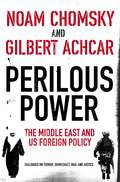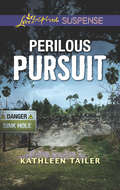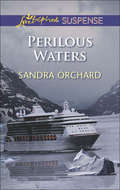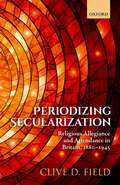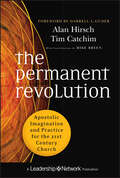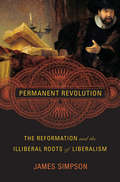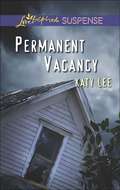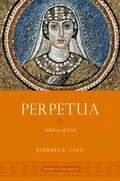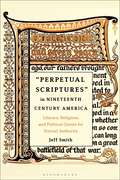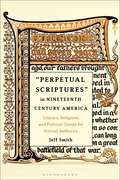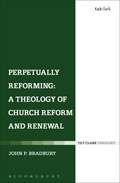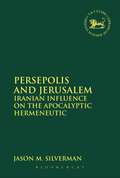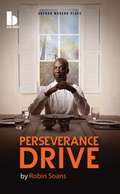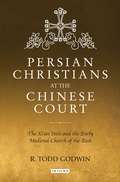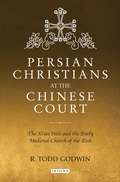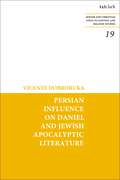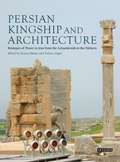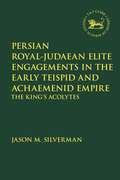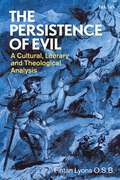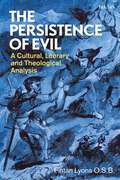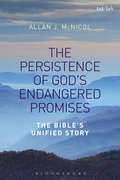- Table View
- List View
Perilous Power: Dialogues on Terror, Democracy, War, and Justice
by Noam Chomsky Gilbert Achcar Stephen R. ShalomThe volatile Middle East is a region of vast resources, frequent crises and long-standing conflicts, as well as a major source of international tensions and a key site of direct US intervention.Noam Chomsky, the preeminent critic on US foreign policy, and Gilbert Achcar, a leading Middle East specialist, bring a keen understanding of the Middle East and the role of the US, covering such key topics as terrorism, fundamentalism, oil and democracy, as well as the war in Afghanistan, the invasion and occupation of Iraq, the Israeli-Palestinian conflict and the origins of US foreign policy.
Perilous Pursuit (Mills And Boon Love Inspired Suspense Ser.)
by Kathleen TailerEvidence in their hands… And a crime ring on their trail.
Perilous Refuge: Hazardous Homecoming Silent Night Standoff Perilous Refuge (Mills And Boon Love Inspired Suspense Ser.)
by Kathleen TailerNowhere to turn
Perilous Waters: Top Secret Identity Wrongly Accused Perilous Waters Lancaster County Target (Mills And Boon Love Inspired Suspense Ser.)
by Sandra OrchardUNDER SUSPICION
Periodizing Secularization: Religious Allegiance and Attendance in Britain, 1880-1945
by Clive D. FieldMoving beyond the (now somewhat tired) debates about secularization as paradigm, theory, or master narrative, Periodizing Secularization focuses upon the empirical evidence for secularization, viewed in its descriptive sense as the waning social influence of religion, in Britain. Particular emphasis is attached to the two key performance indicators of religious allegiance and churchgoing, each subsuming several sub-indicators, between 1880 and 1945, including the first substantive account of secularization during the fin de siècle. A wide range of primary sources is deployed, many of them relatively or entirely unknown, and with due regard to their methodological and interpretative challenges. On the back of them, a cross-cutting statistical measure of 'active church adherence' is devised, which clearly shows how secularization has been a reality and a gradual, not revolutionary, process. The most likely causes of secularization were an incremental demise of a Sabbatarian culture (coupled with the associated emergence of new leisure opportunities and transport links) and of religious socialization (in the church, at home, and in the school). The analysis is also extended backwards, to include a summary of developments during the eighteenth and early nineteenth centuries; and laterally, to incorporate a preliminary evaluation of a six-dimensional model of 'diffusive religion', demonstrating that these alternative performance indicators have hitherto failed to prove that secularization has not occurred. The book is designed as a prequel to the author's previous volumes on the chronology of British secularization - Britain's Last Religious Revival? (2015) and Secularization in the Long 1960s (2017). Together, they offer a holistic picture of religious transformation in Britain during the key secularizing century of 1880-1980.
Periodizing Secularization: Religious Allegiance and Attendance in Britain, 1880-1945
by Clive D. FieldMoving beyond the (now somewhat tired) debates about secularization as paradigm, theory, or master narrative, Periodizing Secularization focuses upon the empirical evidence for secularization, viewed in its descriptive sense as the waning social influence of religion, in Britain. Particular emphasis is attached to the two key performance indicators of religious allegiance and churchgoing, each subsuming several sub-indicators, between 1880 and 1945, including the first substantive account of secularization during the fin de siècle. A wide range of primary sources is deployed, many of them relatively or entirely unknown, and with due regard to their methodological and interpretative challenges. On the back of them, a cross-cutting statistical measure of 'active church adherence' is devised, which clearly shows how secularization has been a reality and a gradual, not revolutionary, process. The most likely causes of secularization were an incremental demise of a Sabbatarian culture (coupled with the associated emergence of new leisure opportunities and transport links) and of religious socialization (in the church, at home, and in the school). The analysis is also extended backwards, to include a summary of developments during the eighteenth and early nineteenth centuries; and laterally, to incorporate a preliminary evaluation of a six-dimensional model of 'diffusive religion', demonstrating that these alternative performance indicators have hitherto failed to prove that secularization has not occurred. The book is designed as a prequel to the author's previous volumes on the chronology of British secularization - Britain's Last Religious Revival? (2015) and Secularization in the Long 1960s (2017). Together, they offer a holistic picture of religious transformation in Britain during the key secularizing century of 1880-1980.
The Permanent Revolution: Apostolic Imagination and Practice for the 21st Century Church (Jossey-Bass Leadership Network Series #57)
by Alan Hirsch Tim CatchimA new brand of apostolic ministry for today's world The Permanent Revolution is a work of theological re-imagination and re-construction that draws from biblical studies, theology, organizational theory, leadership studies, and key social sciences. The book elaborates on the apostolic role rooted in the five-fold ministry from Ephesians 4 (apostles, prophets, evangelists, shepherds, and teacher), and its significance for the missional movement. It explores how the apostolic ministry facilitates ongoing renewal in the life of the church and focuses on leadership in relation to missional innovation and entrepreneurship.The authors examine the nature of organization as reframed through the lens of apostolic ministry. Shows how to view the world through a biblical perspective and continue the "permanent revolution" that Jesus started Outlines the essential characteristics of apostolic movement and how to restructure the church and ministry to be more consistent with them Alan Hirsch is a leading voice in the missional movement of the Christian West This groundbreaking book integrates theology, sociology, and leadership to further define the apostolic movement.
The Permanent Revolution: Apostolic Imagination and Practice for the 21st Century Church (Jossey-Bass Leadership Network Series #57)
by Alan Hirsch Tim CatchimA new brand of apostolic ministry for today's world The Permanent Revolution is a work of theological re-imagination and re-construction that draws from biblical studies, theology, organizational theory, leadership studies, and key social sciences. The book elaborates on the apostolic role rooted in the five-fold ministry from Ephesians 4 (apostles, prophets, evangelists, shepherds, and teacher), and its significance for the missional movement. It explores how the apostolic ministry facilitates ongoing renewal in the life of the church and focuses on leadership in relation to missional innovation and entrepreneurship.The authors examine the nature of organization as reframed through the lens of apostolic ministry. Shows how to view the world through a biblical perspective and continue the "permanent revolution" that Jesus started Outlines the essential characteristics of apostolic movement and how to restructure the church and ministry to be more consistent with them Alan Hirsch is a leading voice in the missional movement of the Christian West This groundbreaking book integrates theology, sociology, and leadership to further define the apostolic movement.
Permanent Revolution: The Reformation and the Illiberal Roots of Liberalism
by James SimpsonHow did the English Reformation, with its illiberal, intolerant beginnings, lay the groundwork for the Enlightenment—free will, liberty of conscience, religious toleration, constitutionalism, and all the rest? In his provocative rewriting of the history of liberalism, James Simpson uncovers its unexpected debt to Protestant evangelicalism.
Permanent Vacancy: Security Breach Backfire Permanent Vacancy (Mills And Boon Love Inspired Suspense Ser.)
by Katy LeeBUYER BEWARE
Perpetua: Athlete of God (Women in Antiquity)
by Barbara K. GoldPerpetua was an early Christian martyr who died in Roman Carthage in 203 CE, along with several fellow martyrs, including one other woman, Felicitas. She has attracted great interest for two main reasons: she was one of the earliest martyrs, especially female martyrs, about whom we have any knowledge, and she left a narrative written in prison just before she went to her death in the amphitheater. Her narrative is embedded in a tripartite telling of the arrest and deaths of these martyrs, the Passio Sanctarum Perpetuae et Felicitatis. The other two parts of her tale were written by Saturus, a fellow martyr and probably her teacher, and a nameless editor or confessor, who introduces her circumstances and group and then tells of her death after she stops writing. Her story is steeped in mystery, and every aspect of her life and death has generated much controversy. Some do not believe that she herself could have written the narrative: the circumstances of her imprisonment and the limitations of her ability to write such a rhetorically complex tale are inconceivable. Some believe that her editor was none other then Tertullian, the famous 2nd-3rd century church father and Perpetua's fellow north African. Some, including Augustine, wonder why the feast day was named only for Perpetua and Felicitas and not for her fellow male martyrs. Some believe that these martyr tales were largely fabricated or constructed in order to generate publicity for the early Christians. This book will investigate and try to make sense of all aspects of Perpetua's life, death, and circumstances: her family and life in Carthage, Christians and Romans in Carthage and in the Roman empire in this period, the comparisons of martyrs to athletes, the influence of these martyr tales upon the Acts of the Apostles and the Greek novel, the reactions of later church fathers like Augustine to her story and her popularity, and the gendering of this text.
Perpetual Scriptures in Nineteenth-Century America: Literary, Religious, and Political Quests for Textual Authority
by Jeff SmithIn the tumultuous decades of rapid expansion and change between the American Founding and the Civil War, Americans confronted a cluster of overlapping crises whose common theme was the difficulty of finding authority in written texts. The issue arose from several disruptive developments: rising challenges to the traditional authority of the Bible in a society that was intensely Protestant; persistent worries over America's lack of a “national literature” and an independent cultural identity; and the slavery crisis, which provoked tremendous struggles over clashing interpretations of the Declaration of Independence and the Constitution, even as these “parascriptures” were rising to the status of a kind of quasi-sacred secular canon. At the same time but from the opposite direction, new mass media were creating a new, industrial-scale print culture that put a premium on very non-sacred, disposable text: mass-produced “news,” dispensed immediately and in huge quantities but meant only for the day or hour. Perpetual Scriptures in Nineteenth-Century America identifies key features of the writings, careers and cultural politics of several prominent Americans as responses to this cluster of challenges. In their varied attempts to vindicate the sacred and to merge the timeless with the urgent present, Joseph Smith, Ralph Waldo Emerson, Margaret Fuller, Theodore Parker, Harriet Beecher Stowe, Walt Whitman, Frederick Douglass, Martin Delany, Abraham Lincoln, and other religious and political leaders and men and women of letters helped define American literary culture as an ongoing quest for new “bibles,” or what Emerson called a “perpetual scripture.”
Perpetual Scriptures in Nineteenth-Century America: Literary, Religious, and Political Quests for Textual Authority
by Jeff SmithIn the tumultuous decades of rapid expansion and change between the American Founding and the Civil War, Americans confronted a cluster of overlapping crises whose common theme was the difficulty of finding authority in written texts. The issue arose from several disruptive developments: rising challenges to the traditional authority of the Bible in a society that was intensely Protestant; persistent worries over America's lack of a “national literature” and an independent cultural identity; and the slavery crisis, which provoked tremendous struggles over clashing interpretations of the Declaration of Independence and the Constitution, even as these “parascriptures” were rising to the status of a kind of quasi-sacred secular canon. At the same time but from the opposite direction, new mass media were creating a new, industrial-scale print culture that put a premium on very non-sacred, disposable text: mass-produced “news,” dispensed immediately and in huge quantities but meant only for the day or hour. Perpetual Scriptures in Nineteenth-Century America identifies key features of the writings, careers and cultural politics of several prominent Americans as responses to this cluster of challenges. In their varied attempts to vindicate the sacred and to merge the timeless with the urgent present, Joseph Smith, Ralph Waldo Emerson, Margaret Fuller, Theodore Parker, Harriet Beecher Stowe, Walt Whitman, Frederick Douglass, Martin Delany, Abraham Lincoln, and other religious and political leaders and men and women of letters helped define American literary culture as an ongoing quest for new “bibles,” or what Emerson called a “perpetual scripture.”
Perpetually Reforming: A Theology of Church Reform and Renewal (Ecclesiological Investigations)
by John P. BradburyOne of the slogans of the reformation was ecclesia reformata semper reformanda – 'the reformed church always reforming'. Churches throughout the western world are currently engaged in reform and renewal programmes through internal structural reforms as well as movements such as 'emerging church'. This book presents a challenging theology of church reform and renewal that offers a contemporary understanding of this historic slogan. Taking an interdisciplinary approach, Bradbury discerns processes and practices which are perpetually reforming and renewing the identity of the church. It examines doctrinal and confessional conceptions of the church, re-examines texts concerned with covenantal renewal and explores Jewish-Christian dialogue as an example of renewal. A constructive theology is offered utilizing the categories of collective memory and mimetic practice. This upholds fundamental Christian identity, whilst driving the process of reform and renewal under God in the context of a three-way relationship between God, the church and the world.
Perpetually Reforming: A Theology Of Church Reform And Renewal (Ecclesiological Investigations)
by John P. BradburyOne of the slogans of the reformation was ecclesia reformata semper reformanda – 'the reformed church always reforming'. Churches throughout the western world are currently engaged in reform and renewal programmes through internal structural reforms as well as movements such as 'emerging church'. This book presents a challenging theology of church reform and renewal that offers a contemporary understanding of this historic slogan. Taking an interdisciplinary approach, Bradbury discerns processes and practices which are perpetually reforming and renewing the identity of the church. It examines doctrinal and confessional conceptions of the church, re-examines texts concerned with covenantal renewal and explores Jewish-Christian dialogue as an example of renewal. A constructive theology is offered utilizing the categories of collective memory and mimetic practice. This upholds fundamental Christian identity, whilst driving the process of reform and renewal under God in the context of a three-way relationship between God, the church and the world.
Persepolis and Jerusalem: Iranian Influence on the Apocalyptic Hermeneutic (The\library Of Hebrew Bible/old Testament Studies)
by Jason M. SilvermanPersepolis and Jerusalem reconsiders Iranian influence upon Jewish apocalyptic, and offers grounds upon which such study may proceed. After describing the history of scholarship on the question of Iranian influence and on Jewish apocalyptic, Jason M. Silverman reformulates the methodology for understanding apocalyptic and influence. Two chapters set the discussion firmly in the Achaemenid Empire, describing the sources for Iranian religion, the issues involved in attempting a historical reconstruction, the methodology by which one can date the various texts and ideas, and the potential loci for Iranian-Judaean interaction. The historical context is expanded through media-contextualization, particularly Oral Theory, and critiques the standard text-centric method of current Biblical Scholarship. With this background, pericopes from Ezekiel, Daniel, and 1 Enoch are analyzed for Iranian influence. The study then brings together the contexts and analyses to argue for an 'Apocalyptic Hermeneutic' which relates the phenomena of apocalypticism, apocalypse, and millenarianism-seeing the hermeneutic as a dialectical thread holding them all together as well as apart- and posits this as the best place to understand Iranian influences.
Perseverance Drive (Oberon Modern Plays)
by Robin Soans‘Tis Grace that brought me safe thus far and Grace will lead me home. – Amazing Grace In the heat of the Caribbean sun and to the familiar sound of gospel hymns, the Gillard family prepares for the funeral of their mother Grace. Tensions ignite as Josh arrives in Barbados after a long absence, and is reunited with his two brothers and their wives. Further complications arise when widowed Eli’s plans for the Bajan home receive a set-back from an unexpected source. London, 4 years later. The table is set with Tiger Malt, lashings of Madeira cake and chocolate digestives (milk, not dark). Secrets are exposed at this last family gathering but Eli knows time is running out: Can the Gillard family reconcile their faith in God with their faith in one another?.
Persian Christians at the Chinese Court: The Xi'an Stele and the Early Medieval Church of the East (Library of Medieval Studies)
by R. Todd GodwinThe Xi'an Stele, erected in Tang China's capital in 781, describes in both Syriac and Chinese the existence of Christian communities in northern China. While scholars have so far considered the Stele exclusively in relation to the Chinese cultural and historical context, Todd Godwin here demonstrates that it can only be fully understood by reconstructing the complex connections that existed between the Church of the East, Sasanian aristocratic culture and the Tang Empire (617–907) between the fall of the Sasanian Persian Empire (225–651) and the birth of the Abbasid Caliphate (762–1258). Through close textual re-analysis of the Stele and by drawing on ancient sources in Syriac, Greek, Arabic and Chinese, Godwin demonstrates that Tang China (617–907) was a cosmopolitan milieu where multiple religious traditions, namely Buddhism, Zoroastrianism, Manichaeism and Christianity, formed zones of élite culture. Syriac Christianity in fact remained powerful in Persia throughout the period, and Christianity – not Zoroastrianism – was officially regarded by the Tang government as 'The Persian Religion'. Persian Christians at the Chinese Court uncovers the role played by Syriac Christianity in the economic and cultural integration of late Sasanian Iran and China, and is important reading for all scholars of the Church of the East, China and the Middle East in the medieval period.
Persian Christians at the Chinese Court: The Xi'an Stele and the Early Medieval Church of the East
by R. Todd GodwinThe Xi'an Stele, erected in Tang China's capital in 781, describes in both Syriac and Chinese the existence of Christian communities in northern China. While scholars have so far considered the Stele exclusively in relation to the Chinese cultural and historical context, Todd Godwin here demonstrates that it can only be fully understood by reconstructing the complex connections that existed between the Church of the East, Sasanian aristocratic culture and the Tang Empire (617-907) between the fall of the Sasanian Persian Empire (225-651) and the birth of the Abbasid Caliphate (762-1258). Through close textual re-analysis of the Stele and by drawing on ancient sources in Syriac, Greek, Arabic and Chinese, Godwin demonstrates that Tang China (617-907) was a cosmopolitan milieu where multiple religious traditions, namely Buddhism, Zoroastrianism, Manichaeism and Christianity, formed zones of elite culture. Syriac Christianity in fact remained powerful in Persia throughout the period, and Christianity - not Zoroastrianism - was officially regarded by the Tang government as 'The Persian Religion'.Persian Christians at the Chinese Court uncovers the role played by Syriac Christianity in the economic and cultural integration of late Sasanian Iran and China, and is important reading for all scholars of the Church of the East, China and the Middle East in the medieval period.
Persian Influence on Daniel and Jewish Apocalyptic Literature (Jewish and Christian Texts)
by Vicente DobrorukaVicente Dobroruka explores Iranian influence on Second Temple Judaism, providing a new explanation of Persian culture and history in the context of biblical accounts by focusing on the spread of Zoroastrian ideas in the period c.300 BCE–200 CE.Dobroruka begins his investigation with an overview of the problems posed by a dualistic worldview-he examines the Indo-European origins of Zarathushtra and his ideas, explores the long-term implications for the notion of free-will, and clarifies the lightness/darkness paradigm that originated in Persia. Following this, Dobroruka discusses a variety of concepts that illustrate this influence, such as the role of matter and the material world, aspects of dualism and the cosmic struggle, the perspectives on the rewards for the just and the opposing punishments for the wicked, the idea of an 'Anointed One', shamanistic visionary experience, the resurrection, and the concepts of Sheol and Paradise.
Persian Kingship and Architecture: Strategies of Power in Iran from the Achaemenids to the Pahlavis (International Library of Iranian Studies)
by Talinn Grigor Sussan BabaieSince the Shah went into exile and the Islamic Republic was established in 1979 in the wake of the Iranian Revolution, the very idea of monarchy in Iran has been contentious. Yet, as Persian Kingship and Architecture argues, the institution of kingship has historically played a pivotal role in articulating the abstract notion of 'Iran' since antiquity. These ideas surrounding kingship and nation have, in turn, served as a unifying cultural force despite shifting political and religious allegiances. Through analyses of palaces, mausolea, art, architectural decoration and urban design the authors show how architecture was appropriated by different rulers as an integral part of their strategies of legitimising power. They refer to a variety of examples, from the monuments of Persepolis under the Achaemenids, the Sassanian palaces at Kish, the Safavid public square of Isfahan, the Qajar palaces at Shiraz and to the modernisation and urban agendas of the Pahlavis. Drawing on archaeology, ancient, medieval, early modern and modern architectural history, both Islamic and secular, this book is indispensable for all those interested in Iranian studies and visual culture.
Persian Royal–Judaean Elite Engagements in the Early Teispid and Achaemenid Empire: The King's Acolytes (The Library of Hebrew Bible/Old Testament Studies)
by Jason M. SilvermanJason Silverman presents a timely and necessary study, advancing the understanding of Achaemenid ideology and Persian Period Judaism. While the Achaemenid Persian Empire (c. 550–330 BCE) dwarfed all previous empires of the Ancient Near East in both size and longevity, the royal system that forged and preserved this civilisation remains only rudimentarily understood, as is the imperial and religious legacy bequeathed to future generations. In response to this deficit, Silverman provides a critically sophisticated and interdisciplinary model for comparative studies. While the Achaemenids rebuilt the Jerusalem temple, Judaean literature of the period reflects tensions over its Persian re-establishment, demonstrating colliding religious perspectives. Although both First Zechariah (1–8) and Second Isaiah (40–55) are controversial, the greater imperial context is rarely dealt with in depth; both books deal directly with the temple's legitimacy, and this ties them intimately to kings' engagements with cults. Silverman explores how the Achaemenid kings portrayed their rule to subject minorities, the ways in which minority elites reshaped this ideology, and how long this impact lasted, as revealed through the Judaean reactions to the restoration of the Jerusalem temple.
The Persistence of Evil: A Cultural, Literary and Theological Analysis
by Revd Fintan Lyons O.S.B.Recording the history of the belief in the existence of Satan, this book draws from the Bible, the poetry of Dante and Milton, the legend of Faust, and from modern novels and plays such as the works of Mark Twain and G.B. Shaw, and the spiritual writing of C. S. Lewis. Fintan Lyons O.S.B. chronicles the decline of that belief through the centuries as well as the attempts to treat the problem of evil philosophically, using the insights of thinkers such as Karl Barth. At the heart of this book is the attempt to synthesise or reconcile traditional belief with contemporary concern or even alarm regarding evil in the world. Lyons argues that evidence for the persistence of evil has been striking in modern times in wars and atrocities, while phenomena such as Satanic Cults and possible or real diabolical possession have continued to increase. The Catholic Church reacted to this situation in 1998 with a revision of the 1614 Rite of Exorcism, analysed in this book from both theological and psychological standpoints. By arguing that the transition from belief in Satan to personification of evil in historical regimes and characters brings contemporary culture into sharp focus, this book chronicles the history of humanity's attempt to understand the disturbing and mysterious reality of evil.
The Persistence of Evil: A Cultural, Literary and Theological Analysis
by Revd Fintan Lyons O.S.B.Recording the history of the belief in the existence of Satan, this book draws from the Bible, the poetry of Dante and Milton, the legend of Faust, and from modern novels and plays such as the works of Mark Twain and G.B. Shaw, and the spiritual writing of C. S. Lewis. Fintan Lyons O.S.B. chronicles the decline of that belief through the centuries as well as the attempts to treat the problem of evil philosophically, using the insights of thinkers such as Karl Barth. At the heart of this book is the attempt to synthesise or reconcile traditional belief with contemporary concern or even alarm regarding evil in the world. Lyons argues that evidence for the persistence of evil has been striking in modern times in wars and atrocities, while phenomena such as Satanic Cults and possible or real diabolical possession have continued to increase. The Catholic Church reacted to this situation in 1998 with a revision of the 1614 Rite of Exorcism, analysed in this book from both theological and psychological standpoints. By arguing that the transition from belief in Satan to personification of evil in historical regimes and characters brings contemporary culture into sharp focus, this book chronicles the history of humanity's attempt to understand the disturbing and mysterious reality of evil.
The Persistence of God's Endangered Promises: The Bible's Unified Story
by Allan J. McNicolUsing a thorough, integrated biblical theology to make sense of the 'master story' of Scripture, Allan J. McNicol explores the nature and importance of the Bible's abiding narrative of the persistence of God's promises to his people, and their hope of final triumph. Special attention is given to the often contentious claim that these early followers of Jesus presumed that they stood in full continuity with Israel, the historic people of God, and were claiming that many of God's promises were coming to fulfilment among them. McNicol presents a closer analysis of the texts as he shows how the theme of the people of God fits into the wider literary productions of these major New Testament writers.
